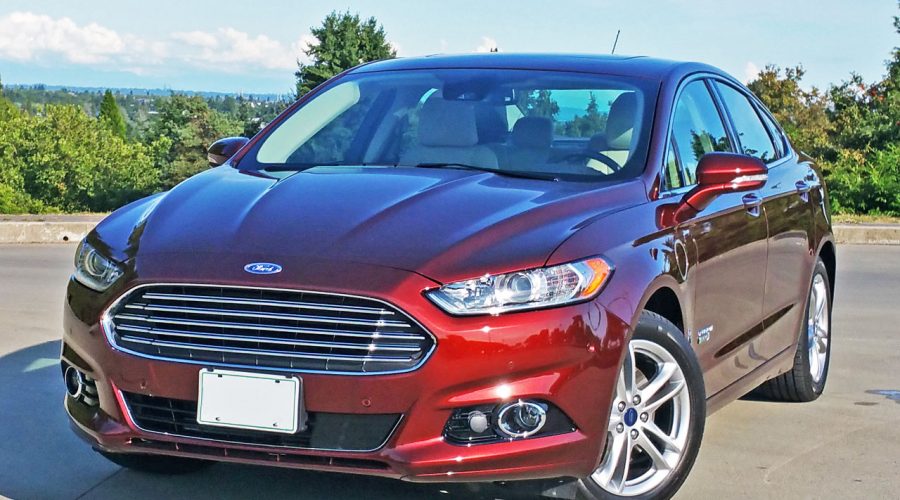Energi is Ford-speak for “plug-in hybrid”, a name it’s only given to two vehicles thus far, the C-Max Energi and this Fusion Energi.
 |
| Photo: Trevor Hofmann, Canadian Auto Press |
Two plug-in models, however, is one more than main competitor Toyota offers, while the domestic brand’s Focus EV means that it’s also ahead of the Japanese brand when it comes to 100-percent electrics.
Interestingly, there isn’t a global brand that offers more plug-in models than the blue-oval, while Ford also makes a couple of regular hybrids, and even more importantly from an environmental perspective, its full lineup of cars, crossovers and trucks offer some of the cleanest, most fuel-efficient direct-injected and turbocharged gasoline powerplants in the industry, along with innovative dual-clutch and multi-speed manual and automatic transmissions. They’ve also got renewable bio-diesels running around Europe, trucks and vans powered by compressed natural gas (CNG) and liquefied petroleum gas (LPG), while the first hydrogen fuel cell vehicle I ever
 |
| Photo: Trevor Hofmann, Canadian Auto Press |
drove was the Ford Focus FCV. When Ford decided to clean up its act along with the world’s air quality, they weren’t kidding.
As for plug-in hybrids, it’s hard not to like the sleek lines of the Fusion Energi, endowed with the same ultra-premium style grille, four-door coupe-like profile, and sporty yet classy rear end treatment as the conventionally powered Fusion. The Energi also gets an attractive aero package including an Audi-like lower fascia air splitter with integrated fogs at each corner, their bezels finished in a glossy black, while body-colour rocker extensions wrap around each side, ahead of a rear deck
 |
| Photo: Trevor Hofmann, Canadian Auto Press |
lid boasting an elevated spoiler on my top-tier Titanium trimmed model, the rear design of both trims finished off with a glossy black panel integrating red reflectors over the bumper cap and a chromed exhaust tip just underneath.
Chrome is used tastefully on the five grille ribs too, plus the grille surround, lower engine vent, fog lamp trim, side window surrounds and, exclusive to the Titanium, the exterior door handles, adding elegance without looking garish, while my top-line tester replaced the base SE’s 17-inch multi-spoke alloys with a sportier looking set of twinned five-spoke 17-inch rims shod in 225/50R17 Michelin Energy Saver rubber, which while attractive looked a tad small compared to the larger rims Ford offers on the conventionally powered
 |
| Photo: Trevor Hofmann, Canadian Auto Press |
Fusion Titanium, but I suppose they’re totally fine for the way most will be driving this fuel-friendly plug-in, a car that’s biased towards comfort and economy over performance, whereas 17s are also a lot less expensive to replace than 18s or 19s.
Another positive, the regular Fusion brings a well-executed interior to the Energi’s attributes. In fact, there’s very little that separates the quality of materials and workmanship from this Titanium’s cabin from the equivalent Lincoln MKZ Hybrid’s inner sanctum. Soft-touch synthetic surfaces run across the top of the dash, down each side of the centre stack and even along the two edges of the lower console, ending near the end of the padded leather centre armrest. Likewise, the top of each door upper is soft front to back, while a thin piece
 |
| Photo: Trevor Hofmann, Canadian Auto Press |
of harder plastic separates the stitched leatherette door insert. It’s all premium-level stuff that’s actually more upscale than some luxury-branded mid-sizers, MKZ aside, while the Fusion’s general interior design is thoroughly appealing with a nice clean layout, ample albeit not overdone metal brightwork, zero fake wood, an appealing two-tone beige and black motif, not to mention a whole lot more space to work with than most plug-ins, so kudos to Ford for reaching above and beyond when it comes to all-round ambiance.
As with all Fords, the Fusion Energi’s electronic interfaces are amongst the best in the biz, the primary gauges incorporating a simple backlit white on black speedometer highlighted by a gorgeous blue needle that spins around its centre. It
 |
| Photo: Trevor Hofmann, Canadian Auto Press |
gets flanked by twin 4.2-inch high-resolution TFT displays with Ford’s newest-generation SmartGauge with EcoGuide content, the left side housing info about the vehicle’s instant and average energy usage, plus a useful braking coach that helps you optimize the regenerative braking system through better pedal technique, and more, all controllable from a cluster of buttons on the left steering wheel spoke, and the right display for audio, compass, range, and exterior temperature, not to mention an alternative green leafy graphic that indicates overall driving efficiency, with leaves that fall off of branches and float away before dissolving into nothing if you’re hard on the throttle, or fill in with green splendor if you’re treading lightly and braking gradually, these features controlled via buttons on the right-side spoke. Yet more switches get fitted in groupings under each spoke, the left side for cruise control and the right for audio volume, phone calls and voice activation.
Next
 |
| Photo: Trevor Hofmann, Canadian Auto Press |
to a backlit ignition button, the gracefully sculpted centre stack receives a large full-colour high-resolution infotainment touchscreen filled with Ford’s superb graphics and the user-friendly MyFord Touch quadrant interface design complete with phone, navigation, audio and climate controls, while just below is a mostly touch-sensitive panel for quick modulation of audio and HVAC functions. I should mention that proximity-sensing passive access gets you inside in the first place, connecting with the pushbutton start/stop system noted a moment ago, while an electronic parking brake adds yet another premium touch.
As you can likely tell from all I’m saying, the Fusion Energi Titanium is well equipped, and it should be for $40,599 plus $1,600 for freight and pre-delivery prep, the extras added to this top-tier trim including
 |
| Photo: Trevor Hofmann, Canadian Auto Press |
the aforementioned passive access with pushbutton ignition, plus remote start, aluminum front scuff plates, aluminum sport pedals, ambient lighting, driver’s side memory, a 10-way powered passenger’s seat, and 12-speaker Sony audio, which sounds fabulous, incidentally.
All this gets added to the base Energi SE, the $38,399 model including standard automatic halogen projector headlights, fog lamps, LED taillights, SecuriCode keyless entry, a nice switchblade style flip key remote, programmable MyKey for teen and valet use, premium floor mats, speed-sensitive intermittent wipers, powered heatable side mirrors with integrated blind-spot mirrors and approach lamps, powered windows with one touch up/down all-round, a leather-wrapped tilt and telescopic multifunction steering wheel, a leather-clad shift knob and boot, leather
 |
| Photo: Trevor Hofmann, Canadian Auto Press |
upholstery, a 10-way powered driver’s sport seat and six-way powered front passenger’s sport seat that are both heatable, dual-zone auto climate control, an electrochromic auto-dimming rearview mirror, compass, exterior temperature gauge, a multi-information display with an integrated trip computer, a Sync with MyFord Touch voice-activated wireless infotainment system with USB and aux inputs, satellite radio, MyFord Mobile, a message centre, and a rearview camera (which is newly standard for 2015), plus rear parking sonar, illuminated vanity mirrors, three 12-volt power outlets, a 110-volt household-style socket, a rear centre armrest with two cupholders, rear HVAC vents, Ford’s convenient capless fuel filler, and believe it or not, more left unmentioned.
The Fusion Energi’s standard safety kit includes four-wheel disc brakes with ABS, electronic
 |
| Photo: Trevor Hofmann, Canadian Auto Press |
brake-force distribution, emergency brake assist, AdvanceTrac traction control with Roll Stability Control, tire pressure monitoring, seat belt pretensioners, the usual six airbags as well as two front knee blockers, an SOS post-crash alert system, the SecuriLock passive anti-theft system, and a perimeter alarm.
My Titanium model also featured a number of extras including a heatable steering wheel at $200, ventilated front seats at $600, adaptive cruise control with collision warning and brake support for $1,500, navigation for $800, a powered sunroof package that adds a universal garage door opener for $1,250, active park assist with a forward sensing system for $600, a driver assist package with blind spot detection and lane keeping assist for $1,450, plus Ford’s exclusive inflatable rear seatbelts at $190.
Those
 |
| Photo: Trevor Hofmann, Canadian Auto Press |
10-way leather covered seats I mentioned earlier are wonderfully comfortable and while I first laughed at Ford for dubbing them “sport seats” I soon appreciated that they have surprisingly good lateral bolstering, keeping you locked in place during hard cornering. Yes, I know I’m talking about a plug-in hybrid here, and not a Mustang, but truth be told Ford doesn’t make very many vehicles that are devoid of dynamic driving characteristics, this one riding on a fully-independent suspension and powered by drivetrain featuring torque vectoring control that makes it as agile as it’s comfortable, although it’s ride is a bit on the firm side for 17-inch rolling stock. It’s commendable handling is especially noteworthy considering that the Fusion Energi’s 1,783-kilo (3,931-lb) curb
 |
| Photo: Trevor Hofmann, Canadian Auto Press |
weight is some 229 kilograms (505 lbs) heavier than the base Fusion with an automatic, let alone 132 kg (291 lbs) heftier than the regular Fusion Hybrid.
Such things considered I had my finger on the EV button as often as stored power would allow, which made the most of the Energi’s efficient powertrain. It consists of a 2.0-litre Atkinson-cycle four-cylinder gasoline engine conjoined to an 88-kW electric motor that gets its energy from a lithium-ion battery. The combination is good for 188 horsepower and 129 lb-ft of torque, while a continuously variable transmission (CVT) sends twist to the front wheels. It’s hardly a revolutionary setup, but keep in mind that Ford was one of the first to offer a full-hybrid powertrain
 |
| Photo: Trevor Hofmann, Canadian Auto Press |
more than a decade ago, and due to this and myriad advancements since holds more than 200 patents on its plug-in hybrid power-split technology alone.
That EV button I just mentioned allows up to 32 kilometres of completely silent all-electric driving, except for tire and wind noise of course, which is kept to a minimum thanks to ample sound deadening processes and materials. An impressive Fusion Energi feature is a top electric-only speed of 136 km/h (85 mph), which, while amazing to experience, is not the best way to maximize battery life. Still, it points to a future of high-speed ultra-clean motoring that only needs
 |
| Photo: Trevor Hofmann, Canadian Auto Press |
more advanced electrical storage to facilitate, something we’re all looking forward to. Once the battery is drained the system switches over to conventional hybrid mode, a seamless process that you’ll likely not notice unless the aforementioned multi-information display didn’t let you know.
Recharging happens two ways. First, regenerative braking will restore battery life slowly just like it does in the regular Fusion Hybrid, and second via the recharging port on the Energi’s left front fender. If you haven’t lived with a plug-in electric vehicle before, you might not realize just how odd it is for that socket to be placed almost as far away from curbside charging stations as possible, in most global jurisdictions
 |
| Photo: Trevor Hofmann, Canadian Auto Press |
that is. I’m guessing Ford wasn’t considering this when they designed the car, the entire charging infrastructure likely not complete in the Fusion Energi’s early development stages, and Ford probably thinking most buyers would simply plug the 120-volt convenience cord located in the trunk into a household socket, a process that Ford claims takes seven hours to complete, or buck up for a 240-volt home charging system that completes the task in just two and a half hours, but I don’t have such easy access to the power grid in my home and therefore made use of the numerous free charging stations around my area, most on city streets and shopping malls. The latter types don’t cause any fuss being that the charging cords are normally hanging on the walls of the parking garage just ahead of the stall, but the former require
 |
| Photo: Trevor Hofmann, Canadian Auto Press |
quite a stretch out to the street. It worked well enough just the same, and I should point out that Ford isn’t alone with its odd socket placement, even all-electric Tesla’s Model S doing likewise, albeit housing its recharging system on the left rear fender. I suppose if it’s good enough for a Tesla, it should be good enough for Ford.
After my first full charge the odometer read 6,933.3 kilometres, its EV range indicator showing a possible 37 km on EV power. After very careful driving, which bordered on hypermiling (the green digital leaves on the Fusion’s right-side display were growing profusely), the powertrain kicked out of EV mode at 6,965.1 km, resulting in a total of 31.8 kilometres of pure EV driving, at which point the left-side multi-info screen warned that the battery was depleted and EV mode would
 |
| Photo: Trevor Hofmann, Canadian Auto Press |
stop. I pressed OK to clear the screen and the engine came back to action so seamlessly that, as mentioned earlier, I wouldn’t have been able to tell without the graphic notice.
Speaking of graphic displays, the battery’s status shows up on a very useful light ring that surrounds the inside edge of the cap while charging, each of its four quadrants sequentially lighting up when another quarter is filled. Charging is completed when a full circle of light rings the plug. It’s an effective way of visually checking the status of your charge, and easier than using a phone app or actually climbing inside to read the display, at least if you’re within close range.
While some aspects of Fusion Energi life are well thought out, some others could use improvement. For instance, unlike other EVs that produce a warning sound designed to give a heads up to pedestrians, the Energi is absolutely silent when running under electric-only propulsion, other than a loud, deep groaning noise coming from under the floorboards (or so it seems) at startup, that’s fortunately not continual. Just in case you’re wondering how I could tell it wasn’t making an outward sound, I pulled the windows down in my parking garage to listen while driving in and out. It’s not a problem of operation, of course, but I certainly paid closer attention to pedestrians than usual, as they had zero warning of my approach and were sometimes taken aback by the sci-fi Fusion’s stealth mobility.
Now that I’m griping (if you can call that last point a complaint), the passenger volume is identically large at 2,911 litres (102.8 cubic feet) whether sitting in a regular Fusion, Fusion Hybrid or this Energi, but that said trunk volume is despairingly different, from a sizable 453 litres (16.0 cubic feet) in conventional guise, to 340 (12.0) for the Hybrid and finally 232 litres (8.2 cubic feet) for the Energi. Yup, these are compact roadster cargo proportions from a large mid-size sedan,
 |
| Photo: Trevor Hofmann, Canadian Auto Press |
but such is the price for such a powerful battery pack. The good news is that the Energi allows expandable access for longer loads via standard 60/40 split-folding rear seatbacks and a pass-through, albeit narrow apertures for sure.
Fuel tank size is less concerning, starting at 62.5 litres for the conventional Fusion with FWD and strangely 66.2 litres with AWD (those numbers are usually switched), while the Hybrid doesn’t lose all that much in the transition to electrification with a 51-litre tank, and Energi actually gains tank capacity with 53 litres. These are things you investigate while waiting for an electric car to recharge, by the way.
On
 |
| Photo: Trevor Hofmann, Canadian Auto Press |
that note I couldn’t wait around for my second charge to fully complete, its projected range only showing 36 km with the A/C off or 34 when engaged, so I opened all the windows as aerodynamics wouldn’t be a factor at city speeds. I started off with 6979.9 km on the odometer and the juice ran out at 7019.4, which means that I achieved 39.5 km, yes, quite a bit beyond my previous experience and more than Ford estimates. You’ve gotta like that, while it’s proof that it doesn’t matter how long you charge it for, per se, but rather the terrain you’re driving over (with more downward slopes allowing for more regenerative braking), the way you’re driving (which I didn’t change), and how many accessories are working in the background (none).
All this careful driving resulted in a weeklong average of 3.7 L/100km via the multi-info
 |
| Photo: Trevor Hofmann, Canadian Auto Press |
display’s onboard computation, this number achievable due to my ability to get work done via laptop all over town, which facilitated many stops at charging stations along the way. Ford claims a five-cycle EnerGuide e-equivalent fuel economy rating of 2.7 L/100km when the electric system is mostly optimized (technically you could pay nothing at all for gasoline if your commute was short and you were able to charge up every day) whereas its gasoline and electric combined hybrid rating is 6.1 L/100km. No matter how you crunch the numbers I was thrilled when it came time to fill up.
I’ve quoted some pretty high prices for a Fusion, my tester actually ringing in at more than $47k before freight, but keep in mind that buyers living in Ontario, Quebec and BC qualify for substantive rebates when purchasing plug-ins, these ranging from $5,000 to $8,500; your dealer will have all the details specific to the Fusion Energi. Also note that at the time of writing Ford is discounting any remaining 2015 Fusion Energi models substantially,
 |
| Photo: Trevor Hofmann, Canadian Auto Press |
while the 2016 model that’s starting to arrive is already available at a significantly reduced rate. Hopefully I’ll be able to report on this newer model sometime in the coming year.
In the end, you can spend a lot more for a lot smaller car with fewer features and less luxuries that isn’t powered by an advanced plug-in hybrid drivetrain, which in itself is a new-age premium experience that’s brings an entirely different kind of prestige and respect to car ownership, not to mention a camaraderie with like-minded EV aficionados you’ll meet up with at charging stations. Speaking as a writer who’s more often then not closed up in a dimly lit office with only my four-wheel thoughts to contend with, EV life opens up a whole new social network.
All in all I have few complaints with the Fusion Energi, all of which are noted, and am only left with one additional recommendation for Ford to ponder. While the Energi name is creative, it’s probably a good idea to tack on the usual “Plug-in” suffix so that your buying public realizes what your chic spin on energy implies. You can spend mega-bucks trying to educate green buyers about your Energi solution to all their polluting problems, or simply go with the flow and call it a Fusion Hybrid Plug-in. Of course, no matter what you call it, the Fusion Energi is a superb mid-size plug-in hybrid with near-luxury pretensions. If you’re considering going electric, give one a try.
©(Copyright Canadian Auto Press)






